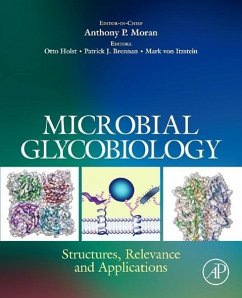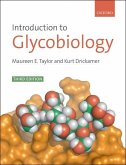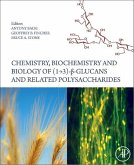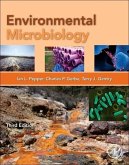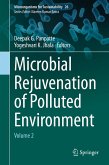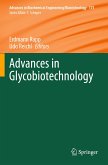Anthony P MoranStructures, Relevance and Applications
Microbial Glycobiology
Structures, Relevance and Applications
Herausgegeben:Holst, Otto; Brennan, Patrick; von Itzstein, Mark
Anthony P MoranStructures, Relevance and Applications
Microbial Glycobiology
Structures, Relevance and Applications
Herausgegeben:Holst, Otto; Brennan, Patrick; von Itzstein, Mark
- Gebundenes Buch
- Merkliste
- Auf die Merkliste
- Bewerten Bewerten
- Teilen
- Produkt teilen
- Produkterinnerung
- Produkterinnerung
This book presents in an easy-to-read format a summary of the important central aspects of microbial glycobiology, i.e. the study of carbohydrates as related to the biology of microorganisms. Microbial glycobiology represents a multidisciplinary and emerging area with implications for a range of basic and applied research fields, as well as having industrial, medical and biotechnological implications.
Andere Kunden interessierten sich auch für
![Introduction to Glycobiology Introduction to Glycobiology]() Maureen E. TaylorIntroduction to Glycobiology82,99 €
Maureen E. TaylorIntroduction to Glycobiology82,99 €![Chemistry, Biochemistry, and Biology of 1-3 Beta Glucans and Related Polysaccharides Chemistry, Biochemistry, and Biology of 1-3 Beta Glucans and Related Polysaccharides]() Chemistry, Biochemistry, and Biology of 1-3 Beta Glucans and Related Polysaccharides150,99 €
Chemistry, Biochemistry, and Biology of 1-3 Beta Glucans and Related Polysaccharides150,99 €![Environmental Microbiology Environmental Microbiology]() Environmental Microbiology116,99 €
Environmental Microbiology116,99 €![The Bacterial Cell Wall The Bacterial Cell Wall]() Guntram SeltmannThe Bacterial Cell Wall121,99 €
Guntram SeltmannThe Bacterial Cell Wall121,99 €![Microbial Rejuvenation of Polluted Environment Microbial Rejuvenation of Polluted Environment]() Microbial Rejuvenation of Polluted Environment177,99 €
Microbial Rejuvenation of Polluted Environment177,99 €![Unlocking the Sialic Acid Code: From Structure to Function in Health and Disease Unlocking the Sialic Acid Code: From Structure to Function in Health and Disease]() SanobarUnlocking the Sialic Acid Code: From Structure to Function in Health and Disease28,89 €
SanobarUnlocking the Sialic Acid Code: From Structure to Function in Health and Disease28,89 €![Advances in Glycobiotechnology Advances in Glycobiotechnology]() Advances in Glycobiotechnology254,99 €
Advances in Glycobiotechnology254,99 €-
-
-
This book presents in an easy-to-read format a summary of the important central aspects of microbial glycobiology, i.e. the study of carbohydrates as related to the biology of microorganisms. Microbial glycobiology represents a multidisciplinary and emerging area with implications for a range of basic and applied research fields, as well as having industrial, medical and biotechnological implications.
Produktdetails
- Produktdetails
- Verlag: Academic Press
- Artikelnr. des Verlages: B978-0-12-374546-0.X0001-6
- Seitenzahl: 1036
- Erscheinungstermin: 1. August 2009
- Englisch
- Abmessung: 241mm x 199mm x 58mm
- Gewicht: 2260g
- ISBN-13: 9780123745460
- ISBN-10: 0123745462
- Artikelnr.: 26767027
- Herstellerkennzeichnung
- Libri GmbH
- Europaallee 1
- 36244 Bad Hersfeld
- gpsr@libri.de
- Verlag: Academic Press
- Artikelnr. des Verlages: B978-0-12-374546-0.X0001-6
- Seitenzahl: 1036
- Erscheinungstermin: 1. August 2009
- Englisch
- Abmessung: 241mm x 199mm x 58mm
- Gewicht: 2260g
- ISBN-13: 9780123745460
- ISBN-10: 0123745462
- Artikelnr.: 26767027
- Herstellerkennzeichnung
- Libri GmbH
- Europaallee 1
- 36244 Bad Hersfeld
- gpsr@libri.de
Part I. Microbial glycolipids, glyoproteins and glycopolymers1. Overview of the glycosylated components of the bacterial cell wall2. Bacterial cell wall envelope peptidoglycan3. Core oligosaccharide and lipid A components of lipopolysaccharides4. O-Specific polysaccharides of Gram-negative bacteria5. Teichoic acids, lipoteichoic acids, and related cell wall glycopolymers of Gram-positive bacteria6. Bacterial capsular polysaccharides and exopolysaccharides7. Bacterial surface layer glycoproteins and "non-classical secondary cell wall polymers8. Glycosylation of bacterial and archaeal flagellins9. Glycosylated components of the mycobacterial cell wall: structure and function10. Glycoconjugate structure and function in fungal cell walls11. Cytoplasmic carbohydrate molecules: trehalose and glycogen12. Glycosylated compounds of parasitic protozoa13. Analytical approaches towards the structural characterization of microbial wall glycopolymers14. Single-molecule characterization of microbial polysaccharides15. Viral surface glycoproteins in carbohydrate recognition: structure and modelingPart II. Synthesis of microbial glycosylated components; A. Biosynthesis and biosynthetic processes16. Biosynthesis of bacterial peptidoglycan17. Biosynthesis and membrane assembly of lipid A18. Biosynthesis of O-antigen chains and assembly19. Biosynthesis of cell wall teichoic acid polymers20. Biosynthesis and assembly of capsular polysaccharides21. Biosynthesis of the mycobacterial cell envelope components22. Biosynthesis of fungal and yeast glycans B. Chemical synthesis23. Chemical synthesis of bacterial lipid A24. Chemical synthesis of the core oligosaccharide of bacterial lipopolysaccharide25. Chemical synthesis of lipoichoic acid and derivatives26. Chemical synthesis of parasitic glycoconjugates and phosphoglycansPart III. Microbe-host glycosylated interactions27. Bacterial lectin-like interactions in cell recognition and adhesion28. Lectin-like interactions in virus-cell recognition: human immunodeficiency virus and C-type lectin interactions29. Sialic acid-specific microbial lectins30. Bacterial toxins and their carbohydrate receptors at the host-pathogen interface31. Toll-like receptor recognition of lipoglycans, glycolipids and lipopeptides32. NOD receptor recognition of peptidoglycan33. Microbial interaction with mucus and mucins34. Mannose-fucose recognition by DC-SIGN35. Host surfactant proteins in microbial recognition36. T-cell recognition of microbial lipoglycans and glycolipidsPart IV. Biological relevance of microbial glycosylated components; A. Environmental relevance37. Extracellular polymeric substances in microbial biofilms38. Physico-chemical properties of microbial glycopolymers39. Microbial biofilm-related polysaccharides in biofouling and corrosion40. Microbial glycosylated components in plant disease B. Medical relevance41. Antigenic variation of microbial surface glycosylated molecules42. Phase variation of bacterial surface glycosylated molecules in immune evasion43. Molecular mimicry of host glycosylated structures by bacteria44. Role of microbial glycosylation in host cell invasionPart V. Biotechnological and medical applications45. Exopolysaccharides produced by lactic acid bacteria in food and probiotic applications46. Industrial exploitation by genetic engineering of bacterial glycosylation systems47. Glycomimetics as inhibitors in anti-infection therapy48. Bacterial polysaccharide vaccines: glycogonjugates and peptide-mimetics49. Immunomodulation by zwitterionic polysaccharides50. Future potential of glycomics in microbiology and infectious diseases
Part I. Microbial glycolipids, glyoproteins and glycopolymers1. Overview of the glycosylated components of the bacterial cell wall2. Bacterial cell wall envelope peptidoglycan3. Core oligosaccharide and lipid A components of lipopolysaccharides4. O-Specific polysaccharides of Gram-negative bacteria5. Teichoic acids, lipoteichoic acids, and related cell wall glycopolymers of Gram-positive bacteria6. Bacterial capsular polysaccharides and exopolysaccharides7. Bacterial surface layer glycoproteins and "non-classical secondary cell wall polymers8. Glycosylation of bacterial and archaeal flagellins9. Glycosylated components of the mycobacterial cell wall: structure and function10. Glycoconjugate structure and function in fungal cell walls11. Cytoplasmic carbohydrate molecules: trehalose and glycogen12. Glycosylated compounds of parasitic protozoa13. Analytical approaches towards the structural characterization of microbial wall glycopolymers14. Single-molecule characterization of microbial polysaccharides15. Viral surface glycoproteins in carbohydrate recognition: structure and modelingPart II. Synthesis of microbial glycosylated components; A. Biosynthesis and biosynthetic processes16. Biosynthesis of bacterial peptidoglycan17. Biosynthesis and membrane assembly of lipid A18. Biosynthesis of O-antigen chains and assembly19. Biosynthesis of cell wall teichoic acid polymers20. Biosynthesis and assembly of capsular polysaccharides21. Biosynthesis of the mycobacterial cell envelope components22. Biosynthesis of fungal and yeast glycans B. Chemical synthesis23. Chemical synthesis of bacterial lipid A24. Chemical synthesis of the core oligosaccharide of bacterial lipopolysaccharide25. Chemical synthesis of lipoichoic acid and derivatives26. Chemical synthesis of parasitic glycoconjugates and phosphoglycansPart III. Microbe-host glycosylated interactions27. Bacterial lectin-like interactions in cell recognition and adhesion28. Lectin-like interactions in virus-cell recognition: human immunodeficiency virus and C-type lectin interactions29. Sialic acid-specific microbial lectins30. Bacterial toxins and their carbohydrate receptors at the host-pathogen interface31. Toll-like receptor recognition of lipoglycans, glycolipids and lipopeptides32. NOD receptor recognition of peptidoglycan33. Microbial interaction with mucus and mucins34. Mannose-fucose recognition by DC-SIGN35. Host surfactant proteins in microbial recognition36. T-cell recognition of microbial lipoglycans and glycolipidsPart IV. Biological relevance of microbial glycosylated components; A. Environmental relevance37. Extracellular polymeric substances in microbial biofilms38. Physico-chemical properties of microbial glycopolymers39. Microbial biofilm-related polysaccharides in biofouling and corrosion40. Microbial glycosylated components in plant disease B. Medical relevance41. Antigenic variation of microbial surface glycosylated molecules42. Phase variation of bacterial surface glycosylated molecules in immune evasion43. Molecular mimicry of host glycosylated structures by bacteria44. Role of microbial glycosylation in host cell invasionPart V. Biotechnological and medical applications45. Exopolysaccharides produced by lactic acid bacteria in food and probiotic applications46. Industrial exploitation by genetic engineering of bacterial glycosylation systems47. Glycomimetics as inhibitors in anti-infection therapy48. Bacterial polysaccharide vaccines: glycogonjugates and peptide-mimetics49. Immunomodulation by zwitterionic polysaccharides50. Future potential of glycomics in microbiology and infectious diseases

